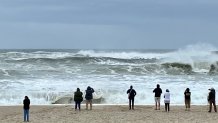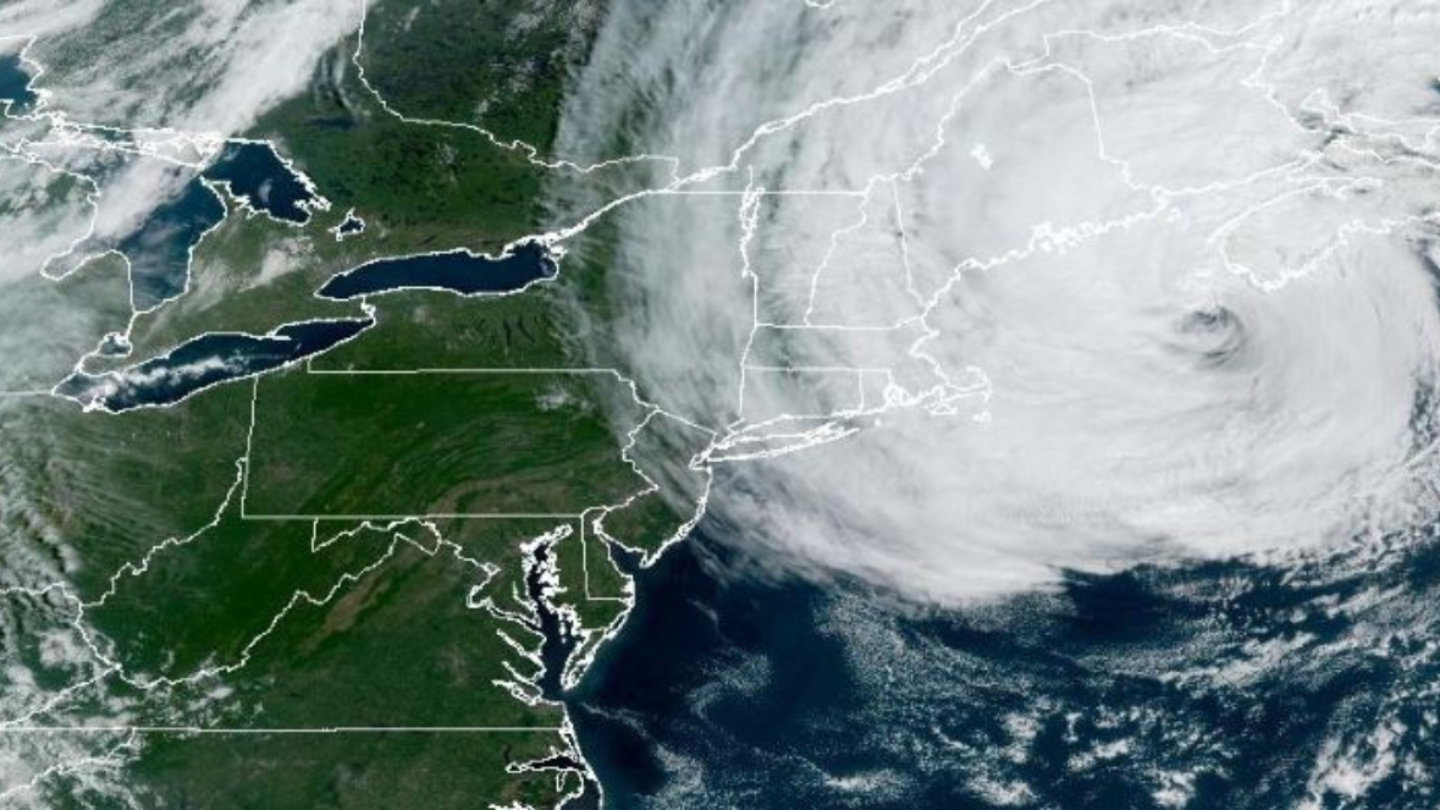Atlantic storm Lee pummeled a large swath of New England and Maritime Canada with destructive winds, rough surf and torrential rains that toppled trees, flooded roadways and cut power to tens of thousands on Saturday. One person was killed in Maine when a tree limb fell on his vehicle.
The center of the sprawling post-tropical cyclone made landfall about 135 miles (215 kilometers) west of Halifax, the capital of Nova Scotia, according to the U.S. National Hurricane Center. That’s about 50 miles (80 kilometers) southeast of Eastport, Maine. It had near-hurricane-strength winds of 70 mph (110 kph), though the storm was weakening as it headed north to New Brunswick and the Gulf of St. Lawrence.
In the United States, a tropical storm warning was in effect for a 230-mile (370-kilometer) stretch from Portsmouth, New Hampshire, to the eastern end of Maine. That included Bar Harbor, the touristy gateway to Acadia National Park, where a whale watch vessel broke free of its mooring and crashed ashore in front of the College of the Atlantic.
Authorities said the Maine Department and Environmental Protection and the Coast Guard were working to offload 1,800 gallons of diesel fuel to prevent it from spilling into the ocean.
Get Boston local news, weather forecasts, lifestyle and entertainment stories to your inbox. Sign up for NBC Boston’s newsletters.
Hurricane-force winds extended as far as 140 miles (220 kilometers) from Lee's center, with tropical-storm-force winds extending as far as 390 miles (630 kilometers) — enough to cover all of Maine and much of Maritime Canada.
The storm was so big that it caused power outages several hundred miles from its center. As of 8:30 p.m. Saturday, more than 65,000 electricity customers in Maine lacked power -- 23,000 of them Versant customers, 40,000 for Central Maine Power, and another 2,100 with the Eastern Maine Power Cooperative. Four hours earlier, more than 95,000 were without power.
In Massachusetts, less than 500 people remained without power as of 8:30 p.m. -- down from 3,000 earlier in the day. Another 1,000 customers were without electricity in New Hampshire.
Coastal Massachusetts was under tropical storm warnings until mid-morning Saturday, when they were dropped. Mass. Gov. Maura Healey lifted the state of emergency Saturday afternoon, a day after it was declared related to Lee, as well as a state of emergency she had declared for flooding that devastated the city of Leominster earlier in the week. President Joe Biden approved a federal emergency declaration for the state Saturday.
Storm surge of 1 to 3 feet was predicted for the Maine coast, and the U.S. hurricane center warned it would be accompanied by large and destructive waves. The storm could drop as much as 4 inches of rain on parts of Maine, Massachusetts, Nova Scotia and New Brunswick through Saturday night, with the potential for local flooding, forecasters said. Flash flood warnings were issued through 9 p.m. for parts of southeastern Maine, including Hancock and Washington counties.
Click here for active weather alerts
A 51-year-old man in Searsport, Maine, died after a large tree limb fell on his vehicle Saturday while he was driving on U.S. Highway 1 during a period of high winds, the first fatality attributed to the storm.
The tree limb brought down live power lines, and utility workers had to cut power before the man could be removed, said Police Chief Brian Lunt. The man died later at a hospital, Lunt said. The man’s identity hasn’t been released.
The storm skirted some of the most waterlogged areas of Massachusetts that experienced severe flash flooding days earlier, when fast water washed out roads, caused sinkholes, damaged homes and flooded vehicles.
“At this point, the storm is resembling a nor’easter,” said Sarah Thunberg, a National Weather Service meteorologist, referring to the fall and winter storms that often plague the region and are so named because their winds blow from the northeast. They typically have a much wider wind field than tropical systems, whose winds stay closer to a storm's center.
But the entire region has experienced an especially wet summer — it ranked second in the number of rainy days in Portland, Maine — and Lee's high winds toppled trees stressed by the rain-soaked ground in Maine, the nation’s most heavily wooded state.
Cruise ships found refuge at berths in Portland, while lobstermen in Bar Harbor and elsewhere pulled traps from the water and hauled boats inland.
Billy Bob Faulkingham, House Republican leader of the Maine Legislature, and another lobsterman survived after their boat overturned while hauling traps ahead of the storm Friday, officials said.
The boat’s emergency locator beacon alerted authorities, and the two clung to the hull until help arrived, said Winter Harbor Police Chief Danny Mitchell. The 42-foot boat sank.
“They’re very lucky to be alive,” he said.
Lee lashed the U.S. Virgin Islands, the Bahamas and Bermuda before turning northward, and heavy swells were causing life-threatening surf and rip currents in the U.S. and Canada, according to the hurricane center.
Forecasters urged residents to stay home: “Nothing good can come from checking out the big waves and how strong the wind truly is," said Kyle Leavitt, director of the New Brunswick Emergency Management Organization.
But many ventured out anyway. Betsy Follansbee and her husband, Fred, jogged to Higgins Beach in Scarborough, Maine, to watch surfers — some wearing helmets — paddling out to catch waves reaching 12 feet (3.6 meters) or more. They were the biggest waves Follansbee has seen in her 10 years living there, she said.
“We’re impressed that that they’re bold enough to try,” Follansbee said.

On Maine’s Bailey Island, a slender spit jutting into the Gulf of Maine, Ren Renton watched the ocean roil.
“The ocean is always dynamic no matter what storm you get,” she said. “It comes and goes and takes what it wants, but hopefully not too much.”
In Rockport, there were wind gusts of up to 47 mph, and some rough waves past the breakwater. But no major damage had been reported as of Saturday morning.
Out on the Cape in Chatham, strong wind gusts and light rain were being reported Saturday morning.
There were spots of damage, though it was not widespread. In Cohasset, a tree came crashing down on a police car, closing the area of South Main Street and River Road. The officer was not hurt.
The harbormaster in Chatham said he expected the worst of the storm to impact Cape Cod Bay, Barnstable and Dennis because the winds are coming out of the northwest. Only minor flooding is expected in Chatham as the wind picks up, along with some beach erosion and power outages.
Between 600-700 boats were removed from the water in Chatham over the course of the past week, with recreational boaters moving their vessels to smaller harbors that offer better protection.
One local resident said he thought conditions would be worse.
"Little disappointing, I thought it'd be worse," said David Sundstrom of Dennis. "But I'm glad this is all we've gotten."
He said his house had already lost power.
"I've got to go to the store to get coffee and ice -- I think I'll persevere," he said. "Use the car to charge the phone, and I have my iPad there too, I've got some Netflix downloaded, and that's it."
Even as New Englanders hunkered down and prepared, they seemed unconcerned by the possibility of violent weather.
In Maine, where people are accustomed to damaging winter nor’easters, some brushed aside the coming Lee as something akin to those storms only without the snow.
“There’s going to be huge white rollers coming in on top of 50- to 60-mph winds. It’ll be quite entertaining,” Bar Harbor lobsterman Bruce Young said Friday. Still, he had his boat moved to the local airport, saying it’s better to be safe than sorry.
Lee shares some characteristics with 2012’s Superstorm Sandy. Both were once strong hurricanes that became post-tropical cyclones — cyclonic storms that have lost most of their tropical characteristics — before landfall. But Lee was not expected to be nearly as destructive as Sandy, which caused billions of dollars in damage and was blamed for dozens of deaths in New York and New Jersey.
Lee also isn't anywhere near as severe as the remnants of Hurricane Fiona, which a year ago washed houses into the ocean, knocked out power to most of two provinces and swept a woman into the sea, said Canadian meteorologist Jill Maepea.
Destructive hurricanes are relatively rare so far north. The Great New England Hurricane of 1938 brought gusts as high as 186 mph (300 kph) and sustained winds of 121 mph (195 kph) at Massachusetts’ Blue Hill Observatory. But there have been no storms that powerful in recent years.
The region learned the hard way with Hurricane Irene in 2011 that damage isn’t always confined to the coast. Downgraded to a tropical storm, Irene still caused more than $800 million of damage in Vermont.




